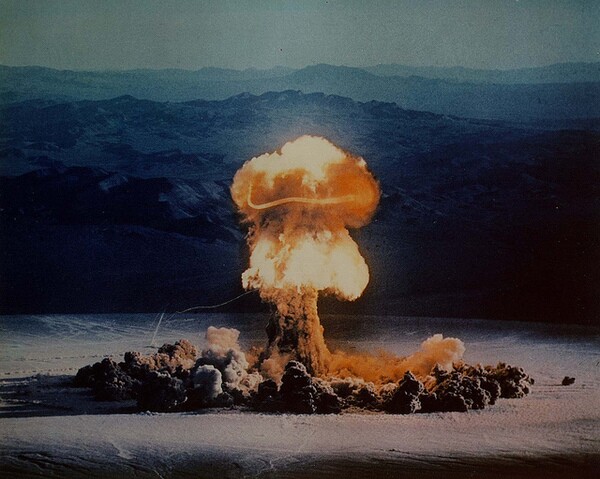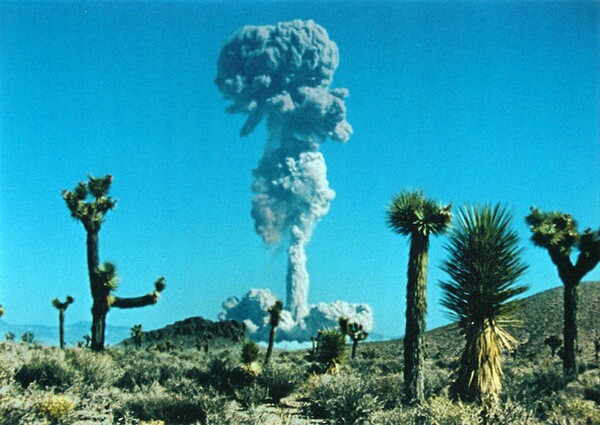50 Years On, Aboveground Nuke Testing Still Shapes the Desert

Today is the anniversary of one of the best things ever to happen to the deserts of the Southwest. On September 24, 1963 the U.S. Senate ratified the Partial Nuclear Test Ban Treaty, effectively ending above-ground nuclear tests conducted by the U.S., the U.S.S.R., and the U.K. The treaty went into effect two weeks later.
The treaty banned all nuclear testing in the atmosphere, in outer space, and under water. It effectively put an end to an era that has since achieved a kind of morbid-tinged camp status, and forever changed our perceptions of the American desert. It was an era that gave rise to that ultimate mid-century image of the desert: arid scenery backdropped by a mushroom cloud.
With this week's anniversary marking a half century since we agreed to stop atmospheric testing, you might be tempted to relegate that era to the distant past. You'd be wrong.
Here is perhaps my favorite, if that is the right word, image of the above-ground testing era in the southwestern deserts. It's Shot Fizeau, detonated at the Nevada Test Site on September 14, 1957. I find the Joshua trees in the foreground evocative, the mushroom cloud behind them echoing their form in a deceptively softer-seeming fashion.

September 14, 1957 was an eventful day. It was a Saturday. Arkansas Governor Orval Faubus met with president Dwight Eisenhower to discuss Eisenhower's concerns over racist reaction to nine African-American students who'd enrolled at Central High School in Little Rock. The show "Have Gun, Will Travel" began its seven-year run on CBS. The White Sox beat the Yankees 5-2 at Yankee Stadium. The United Nations passed a resolution deploring the Soviet invasion of Hungary, which had taken place the previous November. Paul Anka's "Diana" topped the U.S. charts. And at Frenchman Flat, a 31-inch long bomb weighing 131 pounds, 5 ounces exploded atop a 500-foot tower with the force of 11,000 tons of TNT.
Fizeau was one of 29 nuclear detonations held from May though October of 1957 as part of the controversial Operation Plumbbob. Operation Plumbbob accounted for almost a third of the 100 atmospheric tests held at the Nevada Test Site. The prevailing winds on September 14 were from the southeast, and Fizeau's resulting cloud of fallout headed for the coast, passing Reno in about 12 hours and Mendocino County in 24. Circling in a gyre off San Francisco for a couple days, the fallout track then intercepted the jet stream and headed east. Over the next few days the skies over a wide swath of North America played host to Fizeau fallout, from Minnesota and Texas to the Eastern Seaboard.
Fizeau and the other 28 tests in the Plumbbob cohort are thought to have increased U.S. thyroid cancer deaths by somewhere between 1,000 and 20,000 in the years since. With the other 71 tests, they also added as many s 20,000 leukemia deaths to America's total. Likely the most famous effect of nuke testing in the desert came from the film "The Conqueror," shot in 1956 in St. George, Utah, some miles downwind of the Nevada Test Site. Several especially "dirty" bombs had been detonated the year before. Of 220 cast and crew onsite, 91 had developed cancer and 46 had died by 1980, including actors John Wayne, Susan Hayward, Agnes Moorehead, and Pedro Armendáriz.
The blasts didn't claim just human victims. In a 1962 paper with possibly the most chilling title I've ever seen in a scientific work -- "Effects of Nuclear Testing on Desert Vegetation" -- Lora M. Shields and Philip V. Wells detailed how even sturdy, resilient desert plants native to the Mojave desert were faring poorly in recolonizing various ground zeros at the Nevada Test Site. The fast-growing plants burrobush and globemallow, and the native grasses Stipa and Oryzopsis took three or four years to colonize areas within a mile of each studied blast's ground zero.
But there was one plant that did better:
[T]he central portions of all the ground-zero areas have repeatedly produced abundant crops of the highly invasive Russian thistle, Salsola.... This annual tumbleweed, introduced from Eurasia, invaded the ground zeros en masse in the first growing season after the detonation of nuclear weapons.
There's a lot to be said, and I have, about atomic weapons testing being a symbol for our relationship with the desert. It's the ultimate thing no one wants near them. People would choose a toxic waste dump or a sewage sludge processing plant or a killer bee nursery right next door over having atom bombs tested 50 miles upwind. Put those testing sites out in the desert, and only a few desert rats (and unfortunate Hollywood stars) will complain. It's the ultimate symbol of the desert as dumping ground.
But it's those tumbleweeds I'm thinking about. 56 years and a week after Shot Fizeau, one quarter of the Strontium 90 that bomb created is yet with us. A quarter of Fizeau's radioactive cesium 137 is as well. 50 years since the Senate ratified the Partial Test Ban treaty, 21 years since the U.S. last tested a nuclear weapon underground, and the soil in central Nevada still sets off Geiger counters.
Strontium is chemically similar to calcium, and plants take it up readily thinking it's a vital nutrient. Cesium goes into plant roots along metabolic pathways generally used for taking potassium from the soil. Russian thistle is an avid extractor of nutrients from arid soils. For 56 years the plants have scrounged all the radioisotopes they can from the hundreds of ground zeros at the Nevada test site. They set seed fortified with strontium 90 and cesium 137. As the seeds ripen the plants wither. They break off at their roots and the wind drives them where it will, each dropped seed a growing legacy of our playing with Promethean fire.